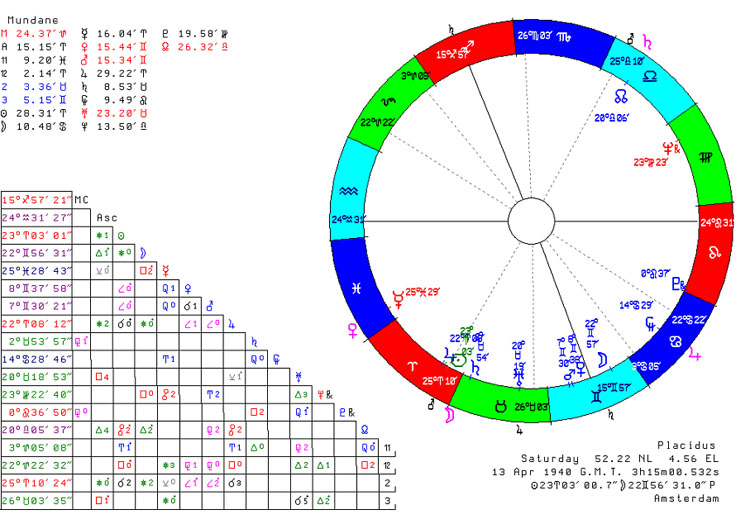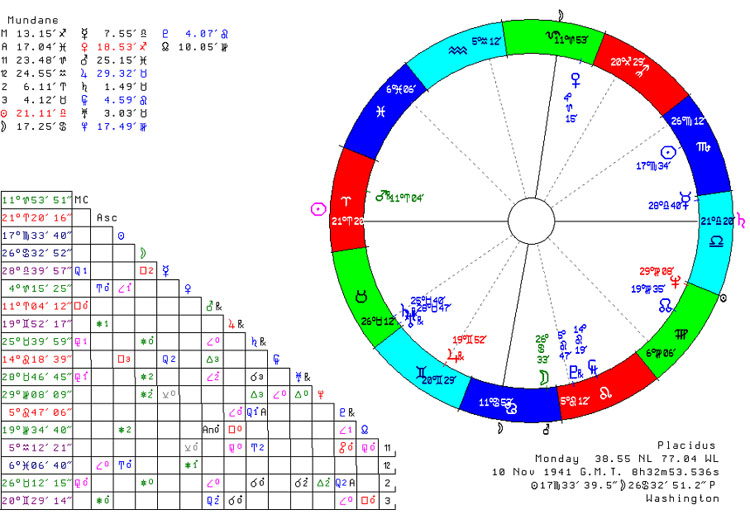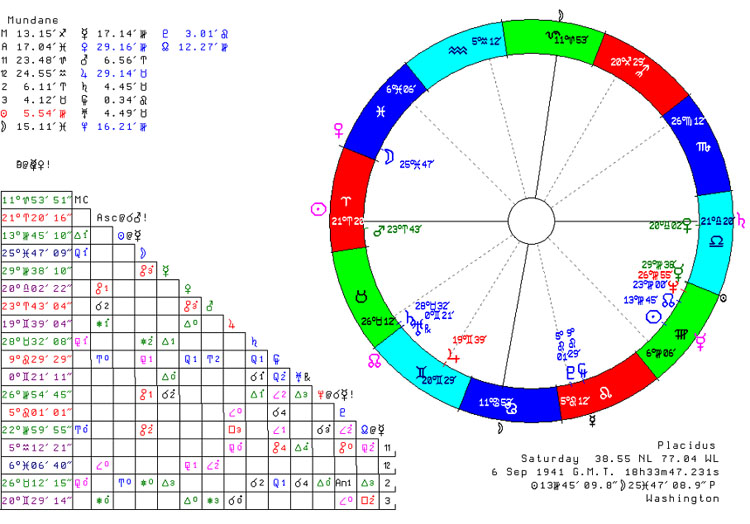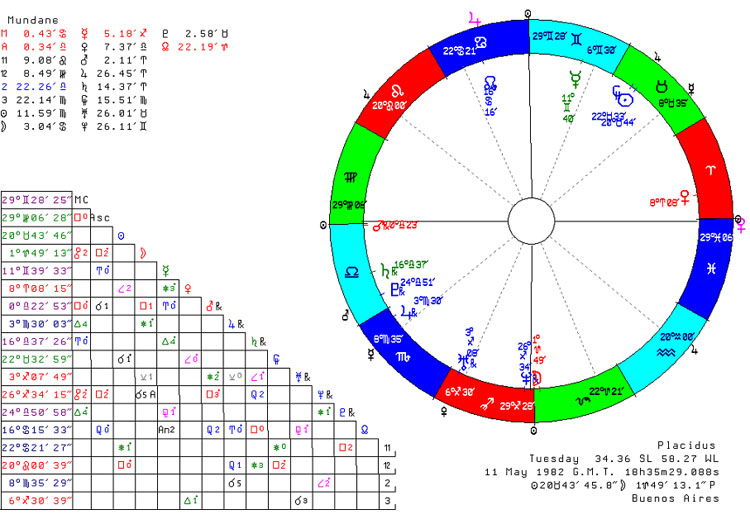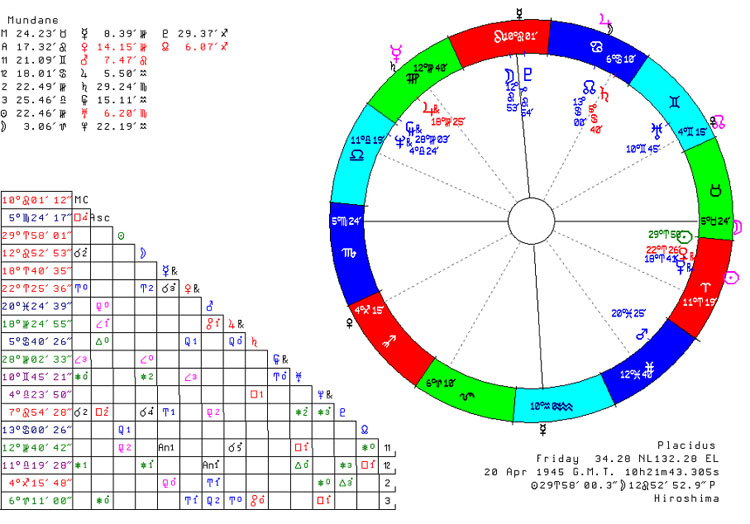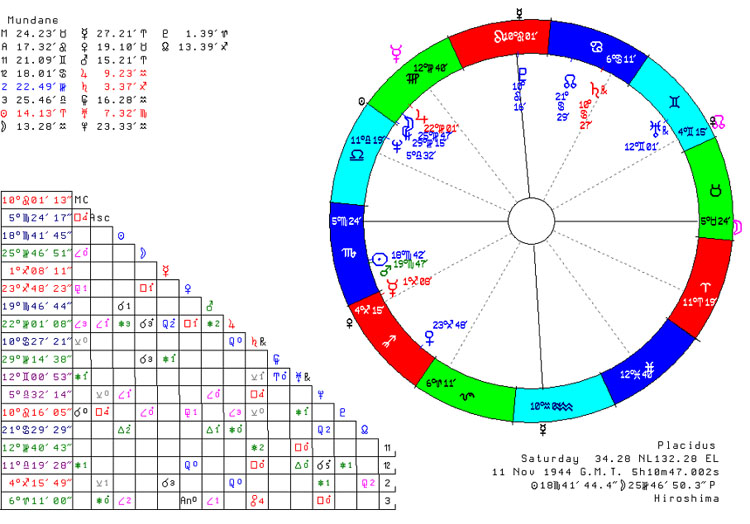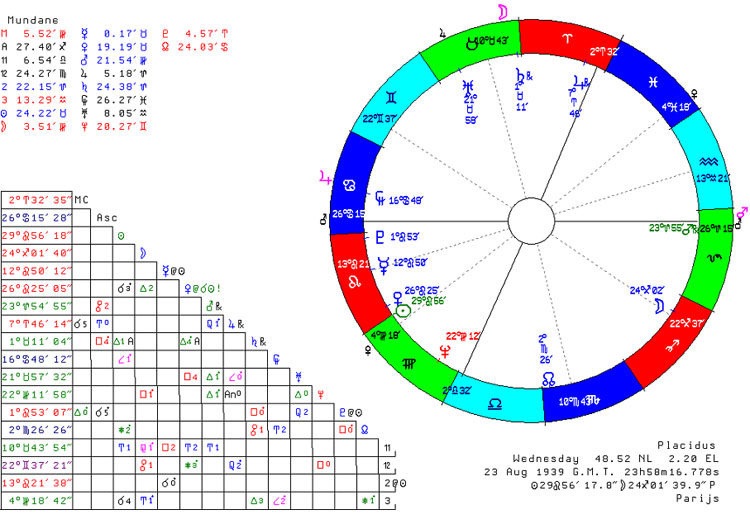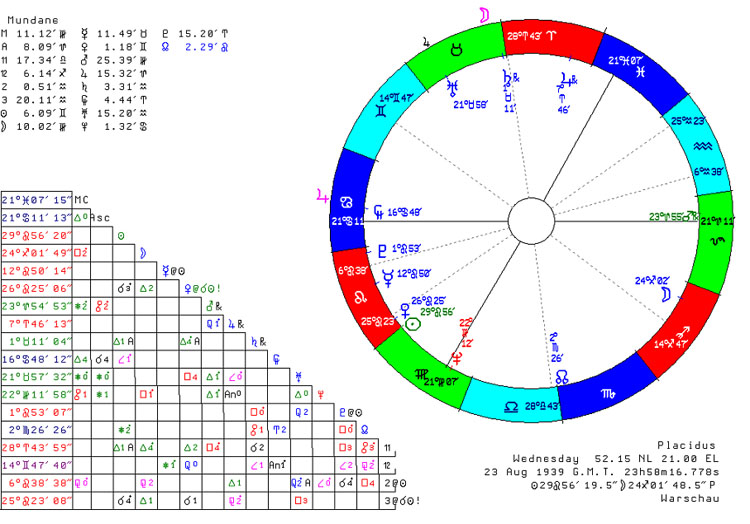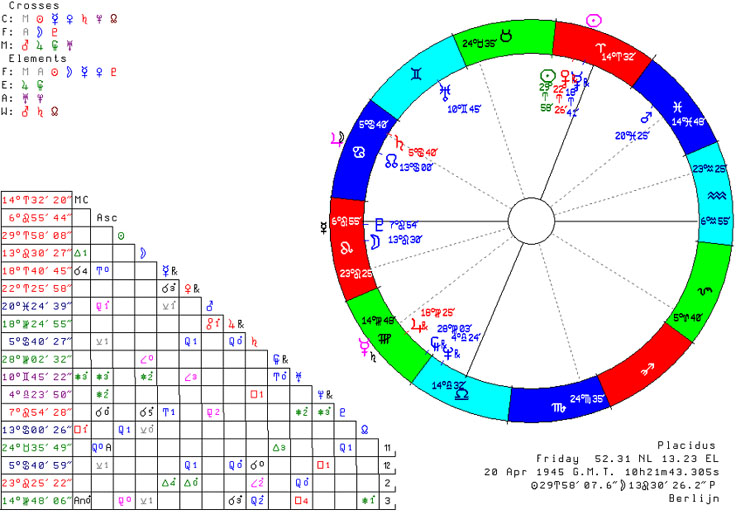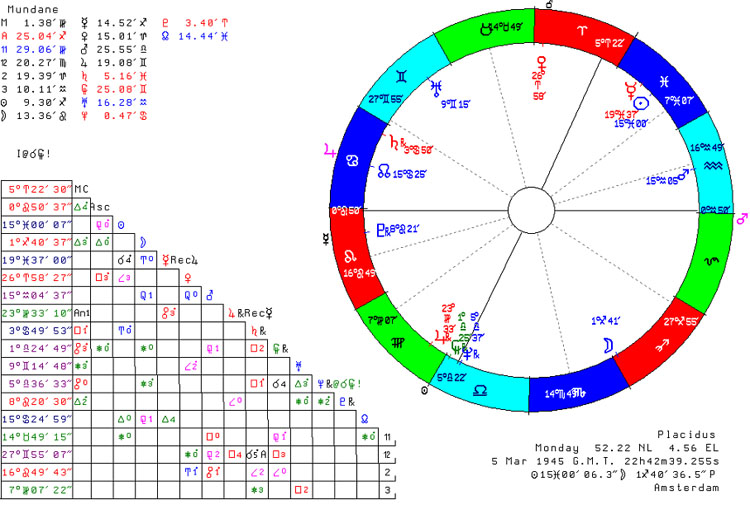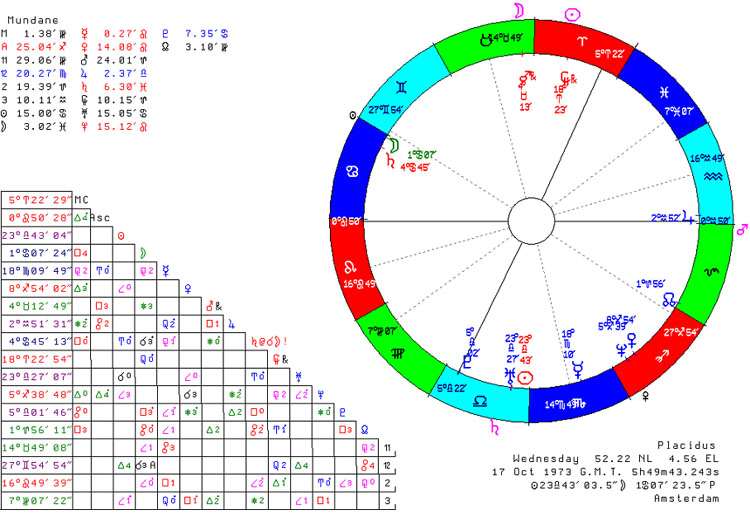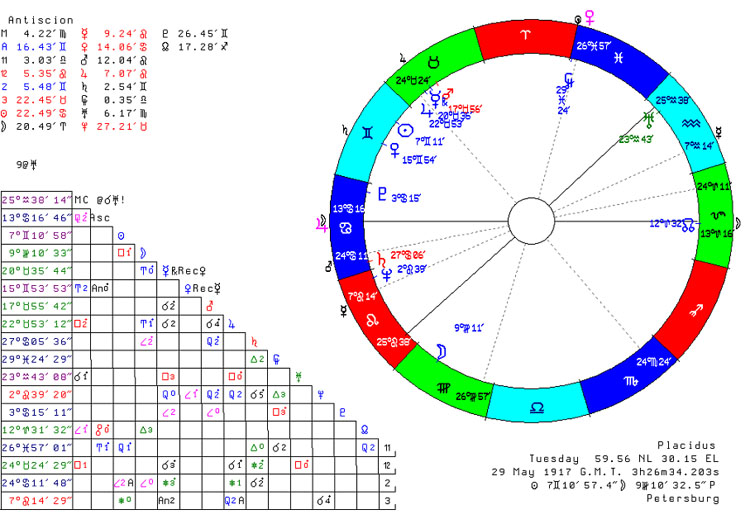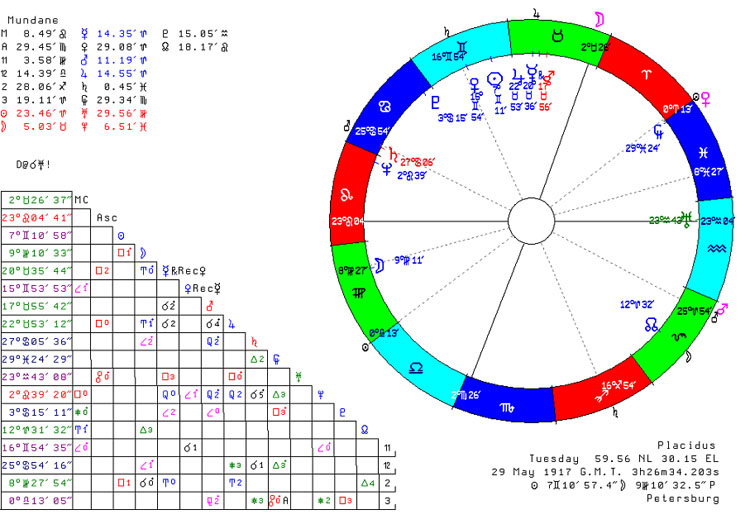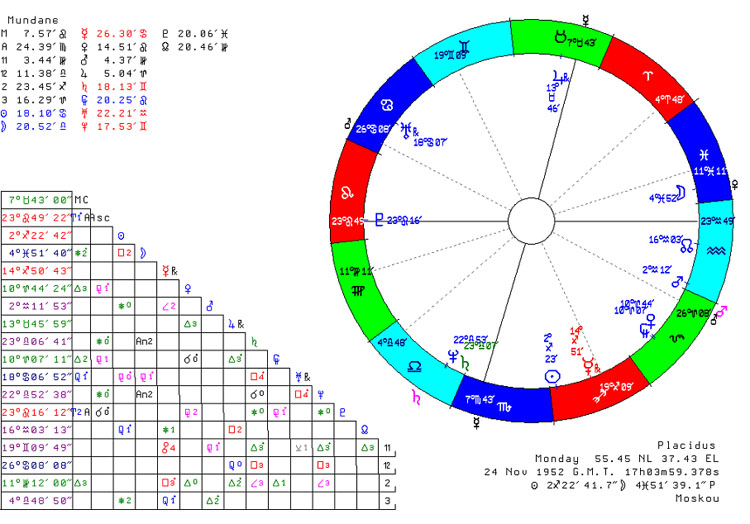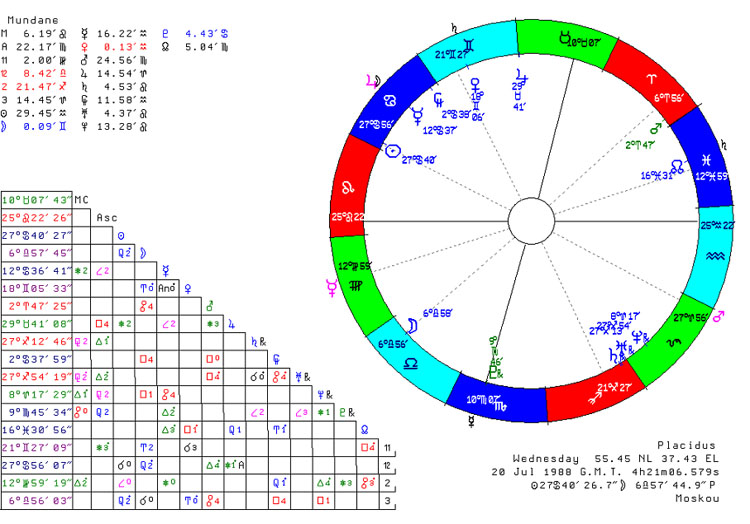Wim van Dam's Corner
|
|
One of the most valued objects in my rather modest astrological library is a little booklet, called “Geodetic Equivalents”, by Sepharial, published by the American Federation of Astrologers, year unknown. For me, when I happened upon it in an astrological bookshop, it meant an introduction to the strangest and most irrational branch of astrology that I work with. There are stranger branches but I don’t believe in them and don’t use them. Whenever I occupy myself with mundane astrology however, I always take a sneaky view of the geodetic equivalent for the horoscope I’m studying. In case you don’t know what it’s all about: in the technique of geodetic equivalents a horoscope is cast for a place on earth in the regular way except that the sidereal time for that place is fixed and directly depends on the local latitude. Take the number of degrees and minutes of a place east of Greenwich and you have the longitude of the local geodetic MC in degrees from the point 0 Aries. For a place west of Greenwich, deduct the local longitude from 360. Thus, Paris is situated at 2.20 east longitude, which gives it a geodetic MC of 2 Aries 20.Then for the local latitude calculate the other cusps in the usual way and you have the geodetic equivalent. The equivalent of what? Usually of a “real” horoscope you calculated earlier, with a correct real sidereal time. STATING OUR THESIS I will now state the rules of the game as I have learned to apply them in order to get the most interesting results:
Let us take as an example the last time when Pluto became stationary (direct) before the Nazi Germans invaded the Netherlands, May 1940. This astrological phenomenon happened April 13th 1940, GMT 3.15 01, and the regular horoscope is like this:
This chart shows Pluto at no more than four minutes of arc from the ascendant. A secondary indication is mundane Pluto in nine, with an orb of less than half a degree conjunct to Mercury. This would be hardly interesting if Mercury were not the ruler of twelfth (secret enemies. The invasion happened most treacherously without preceding declaration of war). Another applicable secondary indication is mundane Mars conjunct to cusp eight. In case you wonder how exact is the time calculated for Pluto’s becoming stationary, a) for the twentieth century and later these times certainly are exact b) remember that even a deviation of an hour of time does not matter very much. CONSIDERATIONS So now you know the trick. It is in fact very simple but certainly rather implausible. Why would there exist an earthly zodiac, equivalent to the astronomical one? Why should the starting point for this geodetic zodiac happen to coincide with man defined zero degrees of longitude at Greenwich observatory? Or, to paraphrase Baigent c.s. (p.294): if this is true, then God must be an Englishman. And yet I think the results of this strange method cannot be simply put aside without further study. There is, however, at least one nasty problem within this theory. Those with a technical turn of mind have often remarked that it is illogical to simply convert the local longitude to zodiacal longitude on the MC. The local longitude should be considered the right ascension of the local MC and accordingly converted. This may give deviations varying from virtually nothing to almost two degrees. I have found cases that give the best results for the approach by longitude and cases that support the view by R.A. (a majority, I suppose). But I realize that the real question should not be: what method gives the most accurate results (less deviations) but: what method gives the most hits, given a certain orb. This is definitely not the same. Thus, the example above with Amsterdam longitude based gave an orb of four minutes of arc. If we accept only R.A. based cases, the orb is 1 degree 12 minutes of arc – considerably larger but still within orb. In other words, it all depends on whether you accept orbs up to two, two and a half degrees so that you can allow yourself to use only one method, (R.A., I suppose), or prefer narrower orbs each time in combination with which of the two methods give the most accurate result. In this article I have, after much deliberation, chosen for the first approach so I limit myself to R.A. based geodetic equivalents if they are within orbs, even if longitude based calculations give a more accurate result. PEARL HARBOR The uncanny thing is, one gets the impression that geodetic horoscopes, at least for stations, give as much fitting results as regular ones. Baigent c.s., clearly embarrassed with this irrational technique, tried to disprove it (p. 206) by showing there are no applicable geodetic indications for the Japanese attack on Pearl Harbor, December 7th 1941. What the authors actually mean is that the local geodetic cusps were not activated by any transits at the time. But they did not see that the last preceding stationary position of Mars was on November 10th, which gives a geodetic horoscope (R.A. based):
Now, if (like me) you prefer cases with conjunctions to cusps to cases with squares, I have a surprise for you. This case was Mars stationary turning to direct, which means Mars turned to retrograde not long before, to be exact on September 6th 1941 and the R.A.-geodetic (R.A. based) equivalent of this station for Pearl Harbor was
giving Mars at 6 minutes from the IC. Besides of this, mundane Pluto is conjunct to the M.C. What we may have overlooked until now is that Pearl Harbor is not the capital of the USA. Turning back to Mars stationary position on November 10th 1941, we may calculate an R.A. based geodetical horoscope for Washington:
with Mars in a square to the MC/IC-axis, orb less than one degree. The earlier date, September 6th, gives the following result for Washington (R.A. based):
Mars is on the ascendant, just within orb (2 degrees 23 minutes). The longitude based orb is far smaller, but we agreed to use only R.A. based ones. This is a pattern I regularly meet: when a planet’s last preceding station before an event is going direct, as much or more information is given by the preceding station (going retrograde). Somehow, a retrograde station seems not to lose its influence by the next station that will always be direct. I have called this the Skipping Rule and we will meet more cases in this article. I have found no cases of the reverse (stationary planet turning to retrograde, more information given by preceding direct station), which is reassuring, for the distance in time from a planet becoming retrograde to becoming direct again is usually far shorter than the reverse. The results for Washington are the same as for Pearl Harbor since the axis MC-IC for Pearl Harbor is almost the same as the axis Asc-Desc for Washington. This gives a link: Washington could not get involved into war without Pearl Harbor being attacked (one wonders how this is nowadays? Or a sceptic might suggest that both stations of Mars related to Washington only and that it is purely coincidental that Pearl Harbor’s geodetic IC coincides with Washington’s geodetic ascendant.) ENGLAND AT WAR It is a pity that Baigent c.s. as it seems overlooked a then recent impressive case of geodetic astrology that should appeal to British researchers especially. Their book is from 1984, and on May 11th 1982 Mars was stationary in the geodetic IC of London :
I saw this in my ephemeris about one year earlier and I was perplexed. This could only mean that Great Britain was to be at war in 1982, which I thought, impossible and a refutation of the whole theory of geodetic equivalents. And what happened? The Falkland war broke out! Since then I have great trust in using geodetic equivalents. This is the more an interesting case since a regular horoscope for the same phenomenon for the opponent (Buenos Aires) shows Mars less than one and half a degree from the ascendant:
even stressed by the mundane ascendant, that happens to be almost conjunct to the regular ascendant. THE BOMB There is one more subject in Baigent (p.296) that needs discussion: The atom bomb. The authors note that Hiroshima has its geodetic MC (longitude based) at 12 Leo 28. When the atom bomb fell Pluto was at 9 Leo 58 and the sun at 13 Leo 09. The authors consider this a good example of a positive case that can always be found to support any thesis. The truth is far more subtle however. Pluto’s last station (direct going) before the Bomb fell was april 20th 1945 at 7 Leo 54, which was just 24 minutes of arc from Nagasaki’s M.C, R.A. based:
For Hiroshima the best we can get from this station is a conjunction with the geodetic longitude based MC:
with an orb of two degrees and seven minutes which is just within orbs and we would have to do with that if we could not take resource to the Skipping Rule: the last time Pluto became retrograde was November 11th 1944 at 10 Leo 16, and for Hiroshima this gives the following geodetic horoscope (R.A.based):
Showing Pluto at 15 minutes of arc in the MC. Uranus, also often linked with the nuclear bomb, had its mundane position in the ascendant. So both Hiroshima and Nagasaki were rather exactly indicated (R.A. based) by the two last stations of Pluto before the bomb fell.
The last time Mars was stationary before the beginning of this war was August 23rd 1939 which at first sight does not give any interesting geodetic indication. But this was a direct station and if we apply our Skipping Rule we can look at this horoscope as well:
June 22nd 1939, Mars is less than one and a half degree from the geodetic (R.A.) descendant for Berlin. For Paris the case of Mars station on August 23rd mentioned above gives a conjunction to the R.A. based geodetic descendant with an orb of 2 degrees and 20 minutes:
It is just within orbs. It is tantalizing that for London the same calculation gives an orb of 2 degrees 33 minutes which falls just outside the orb I use. The same with a regular horoscope for this station for Warszaw, capital of attacked Poland:
where Mars is conjunct to the descendant with 2 degrees 44 minutes. I might have to redefine my maximum orbs. THE END OF WORLD WAR II Based on our study above, the German attack and the total collapse of the Netherlands were indicated by stationary Pluto on the Amsterdam geodetic ascendant, April 13th 1940. Most satisfying, the final German collapse in 1945 was indicated in the same way by Pluto becoming direct on April 20th (Hitler’s last anniversary, by the way):
positioned at hardly one degree from the geodetic ascendant (R.A.) Before WW II ended, the Dutch had to go through a winter of starvation, Hunger Winter as we call it. In the half of the country that had not yet been liberated, thousands of people died from hunger and cold, people were fighting in the streets for food and farmers got rich by selling food at extortionate prices. The planet that rules this situation of lack of food is of course Saturn, and the last time it was stationary before the end of the war was March 5th 1945, which gives the following geodetic (R.A. based) horoscope:
From relevant Saturn we see a square to the MC (one and half a degree orb) and its mundane position is conjunct to cusp nine, indicating the source of the problem. Further, Mars is conjunct to cusp eight, together with mundane Uranus ruler of eight, and mundane Pluto is conjunct to the MC so there is no lack of lethal indications. Very nice is Saturn’s zodiacal position in Cancer, traditionally the sign of Holland (and of the stomach). Almost 30 years later this situation was somehow repeated. September 1973, the Yom Kippur War broke out between Israel and its Arabian neighbours, and the Dutch especially made no secret of their sympathy for the Israeli side. This resulted in an Arabian boycott of the Netherlands. Oil supply was limited and lack of petrol and other oil products are also an issue. The situation was very threatening and I vividly remember our then Prime Minister, Joop den Uyl making a most serious speech on TV. He explained to his people that the good times from before this war were never to return again. Sadly, we all nodded in assent before our television sets. To start with, a prohibition was proclaimed on tanking petrol on Sundays and later on driving cars on Sundays too. Petrol was rationed. In about a month or six weeks it was all over, although this was never officially stated by the government. Everyone knew it although it was not published or mentioned on any news for fear of openly offending the Arabian countries. Saturn became retrograde October 17th 1973 and the corresponding geodetic (R.A. based) horoscope for Amsterdam (see chart below):
where we see, just like 30 years before, Saturn in 4 Cancer in twelve, square to the Amsterdam MC (orb 37 minutes of arc), in mundane conjunction to cusp nine. The lack of oil for the Netherlands is indicated by Pluto being square to Saturn and conjunct to the Amsterdam IC (orb 20 minutes of arc). In a trine to this Pluto we see Jupiter in Aquarius at the descendant, probably indicating the benefic outcome of this storm in a teacup. In case you have a doubt whether indeed Saturn square to Pluto meant lack of oil (many astrologers think oil is ruled by Neptune), I draw your attention to as far as I know the first oil crisis in history, during the Suez Crisis, autumn 1956. The ephemeris for October 1956 is shown below:
shows the two planets were in a square on October 7, 1956. Later oil crises showed the tendency to coincide with unlucky aspects between Saturn and Pluto as well, but this is not within the scope of this article. THE RUSSIAN REVOLUTION Due to deviating calendars, the Russian October Revolution (in spite of its name took place in what we call November 1917), the most probable station of Uranus to study is the direct one on October 30th 1917 GMT 10.31. This chart gives an interesting regular horoscope:
with Uranus square to the MC, and geodetically (longitude) the same station puts
Uranus just within two degrees from the descendant. Remember that Petrograd (“Sankt Peterburg”) was the capital of imperial Russia, not Moscow. Interestingly, Uranus was also in Aquarius, the traditional sign of Russia. This is one case where geodetic based on longitude gives an acceptable orb and based on R.A. not (more than three degrees off). But we may apply our Skipping Rule once more, for Uranus last preceding retrograde station on May 29th gives the following regular horoscope :
Uranus at the MC (orb less than two degrees), and the following geodetic one (R.A. based):
Uranus is positioned at 39 minutes of arc from the descendant. This revolution developed into Stalinistic terror, collapsing with Stalin’s death on March 5th 1953. Just like the end of Hitler’s rulership this was indicated by Pluto’s direct station at the geodetic ascendant (R.A. for Moscow), on November 24th 1952:
Pluto is less than half a degree in the ascendant. The adversaries of the geodetic theory may explain how coincidental it is that both great dictatorships of twentieth century Europe should end with the same indication: as if after Hitler’s death, indicated by Pluto on Berlin’s ascendant, Stalin had waited for this planet, travelling to Moscow, to die. THE END OF THE SOVIET UNION Somewhere in the beginning of the eighties I noticed that July 20th 1988 Pluto was to have an R.A. station in Moscow’s geodetic IC with an orb of only 22 minutes.
From this, I concluded that Soviet power was to collapse by the end of the eighties. The actual fall came a year later than I expected but I comforted myself with the thought that the Soviet Union had been tumbling down like Jericho for years before 1989. Anyway, my unpublished forecast was better (and earlier) than that of most Kremlin watchers. With this I leave the reader and let them conclude for themselves whether the theory of geodetic equivalents is worthwhile for further investigation or not. I certainly will not state that there is a one to one relationship between geodetic phenomena and clearly corresponding events but then, what astrological rule can be said to always tally ? POST SCRIPTUM ON THE SKIPPING RULE Maybe we don’t need the Skipping Rule at all. Possibly, we humans (or at least your reporter) are wrong in considering all stationary positions of one kind, whether the planet turns to retrograde or to direct. Nature might see them as phenomena as different from each other as ingresses from eclipses, which would explain all cases where we need the Skipping Rule. References: Baigent M., Campion N. and Harvey, C. : Mundane Astrology, An Introduction to the Astrology of Nations and Groups, Aquarian Press, Wellingborough, 1984
|

